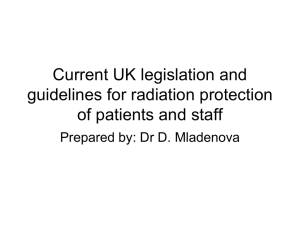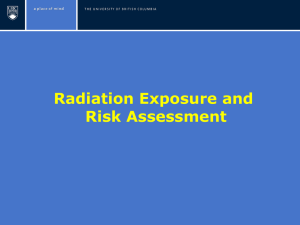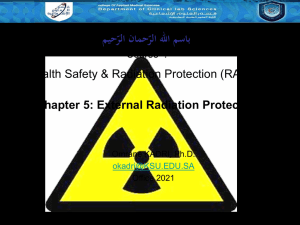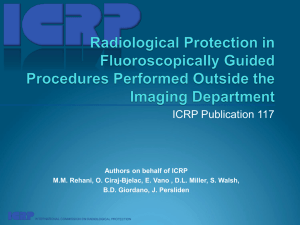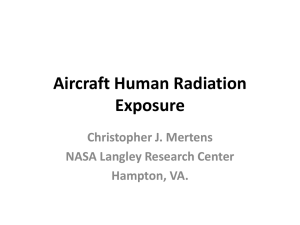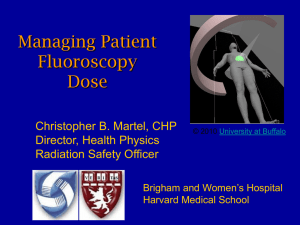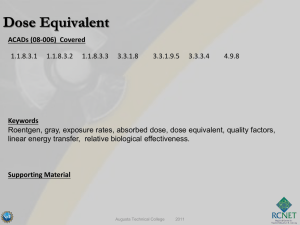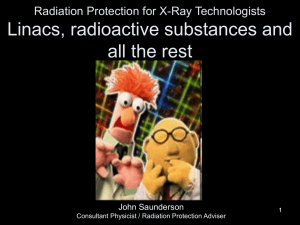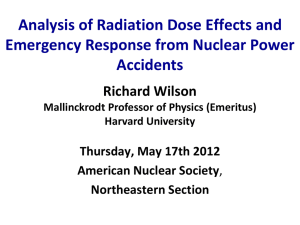Radiation Safety for Anesthesiologists
advertisement
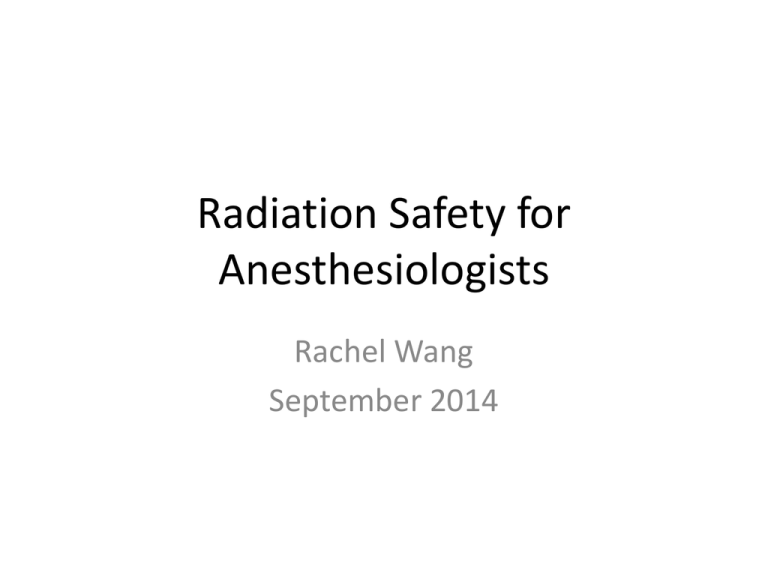
Radiation Safety for Anesthesiologists Rachel Wang September 2014 Physics • X-rays are produced by accelerating electrons through high voltage (50-150 kVp) applied to a tungsten target in an x-ray tube Adverse Effects • Deterministic effects – Cell death at tissue level • Skin injuries, lens opacities, infertility – Predictable when dose exceeds certain thresholds • Stochastic effects – Development of cancer from direct DNA ionization or creation of hydroxyl radicals that cause DNA damage which is not repaired in time – Cumulative effects with long latency period Quantification of Exposure • Absorbed dose (unit: mGy) – Amount of ionizing radiation energy absorbed by a unit mass of material • Equivalent dose (unit: mSv) – Absorbed dose multiplied by a radiation weighting factor (wR) specific to type of radiation (x-ray, alpha particles, etc.) – Accounts for biologic “harmfulness” of different types of radiation – For diagnostic x-rays, wR=1 Quantification of Exposure (cont.) • Effective dose (unit: mSv) – Weighted sum of equivalent doses in all specified tissues and organs – Calculated by multiplying equivalent dose to each organ by a weighting factor (WT) determined by the organ’s radiosensitivity – Used to estimate overall long-term risk Organ/Tissue WT Organ/Tissue WT Bladder 0.04 Lung 0.12 Bone marrow 0.12 Liver 0.04 Bone surface 0.01 Salivary Glands 0.01 Brain 0.01 Skin 0.01 Breast 0.12 Stomach 0.12 Colon 0.12 Thyroid 0.04 Esophagus 0.04 Gonads 0.08 Remainder* 0.12 *adrenals, extrathoracic region, gallbladder, heart, kidneys, lymphatic nodes, muscle, oral mucosa, pancreas, prostate, small intestine, spleen, thymus, uterus/cervix Average Radiation Doses • Natural background radiation: 1-3 mSv/yr • For patients – – Fluoroscopy: 2-20 mSv/min Dose Limits • Based on epidemiological studies of atomic bomb survivors and radiation workers b Statement on Tissue Reactions (approved by the ICRP in 2011) proposed a limit of 20 mSv/yr, averaged over 5 years, not exceeding 50 mSv in any single year Radiation and Pregnancy • National Council on Radiation Protection and Measurements (NCRP) recommends occupational fetal radiation exposure <5 mSv for entire pregnancy or <0.5 mSv/month of pregnancy • International Commission on Radiological Protection (ICRP) recommends <1 mSv for entire pregnancy • Pre-conception irradiation of either parent’s gonads has not been shown to result in increased risk of cancer or malformations in offspring Radiation and Pregnancy (cont.) Dose to conceptus (mGy) above natural background 0 1 5 10 50 100 • Probability of no malformation (%) Probability of no cancer (0-19 years) (%) 97 97 97 97 97 97 99.7 99.7 99.7 99.6 99.4 99.1 Potential non-cancer health effects of prenatal radiation exposure in doses >500 mGy – Less than 2 weeks: unknown – 2–7 weeks: death, miscarriage, growth retardation, and neuromuscular deficiencies – >8 weeks: miscarriage, severe mental retardation, growth retardation, brain and major malformations • • Threshold doses for these deterministic effects are well above those received by healthcare professionals wearing appropriate protective aprons Probability of live birth without malformation or cancer is reduced by – 0.002% following conception exposure of 0.5 mSv – 0.1% following exposure of 10 mSv • In-utero exposure to ionizing radiation at any dose is associated with increased risk of childhood malignancy, esp. leukemia (>6% in doses above 500 mGy) Sources of Occupational Exposure • Of 1000 photons reaching the patient, 100-200 scattered, 20 reach image detector, rest are absorbed • Direct exposure • Scattered radiation from patient – Majority of occupational exposure – 1/1000 of entrance skin exposure rate at 1 meter from center of field – Larger patients generate more scatter 2/2 increased voltage and current of X-ray beams used for better visualization • Leakage x-rays – Equipment regulations limit max leakage level to 1 mGy/h at 1 meter from X-ray tube for max tube potential and current – Typically 0.001-0.01 mGy/h at operator’s position – Equipment should be checked periodically for radiation leakage Factors Affecting Staff Doses • Nonmodifiable factors – Patient related • Complexity of procedure • Body size – Physician related • Experience • Modifiable factors – – – – – Duration Distance (inverse square law) Shielding Education Monitoring Factors Affecting Staff Doses (cont.) ANGLE DEPENDENCE 100 kV 1 mA 0.9 mGy/h 0.6 mGy/h 11x11 cm 0.3 mGy/h 1m patient distance patient thickness 18 cm Factors Affecting Staff Doses (cont.) FIELD SIZE DEPENDENCE 100 kV 1 mA 11x11 cm 17x17 cm 0.8 mGy/h 1.3 mGy/h 0.6 mGy/h 1.1 mGy/h 0.3 mGy/h 0.7 mGy/h 1m patient distance Patient thickness 18 cm Factors Affecting Staff Doses (cont.) DISTANCE VARIATION mGy/h at 0.5m mGy/h at 1m 100 kV 1 mA 11x11 cm Factors Affecting Staff Doses (cont.) • If possible, stand on side of image intensifier rather than X-ray source Radiation Exposure of the Anesthesiologist in the Neurointerventional Suite. Anastasian, Zirka; Strozyk, Dorothea; Meyers, Philip; Wang, Shuang; Berman, Mitchell Anesthesiology. 114(3):512-520, March 2011. DOI: 10.1097/ALN.0b013e31820c2b81 Fig. 3. Distribution of scatter radiation from a lateral xray source. Plan of interventional radiology procedure room showing distribution of scatter radiation from a lateral C-arm. There were higher concentrations of scatter on the side with an x-ray source, for each step increase of 0.5 m from the patient. Measurements were taken from a cardiac catheterization laboratory. Units are [mu]Sv radiation exposure to personnel per Gy [middle dot] cm2 of total radiation emitted by the x-ray tube. This figure was modified and used with permission from page 64 of the following: Valentin J. Avoidance of radiation injuries from medical interventional procedures. Ann ICRP 2000; 30:7-67. Shielding • Structural – Embedded into walls of radiology suite – Mobile, transparent leaded acrylic shields • Equipment-mounted – Leaded drapes suspended from fluoroscopy table/scanner • Personal – – – – Aprons Thyroid shields Eyewear Gloves Personal Protective Devices • Aprons – Traditionally made of lead-impregnated vinyl/rubber – Newer lighter-weight materials include barium, tungsten, tin, and antimony (alone or composite w/ lead) – Wrap-around style typically 0.25 mm lead-equivalent double thickness anteriorly provides 0.5 mm lead equivalence – Transmission of 70–100 kVp x-rays through • 0.5 mm lead: 0.5%–5% • 0.5 mm lead-equivalent composite and lead-free aprons: 0.6% to 6.8% – Should be stored on hangers with minimal folds – Should be inspected under fluoroscopy annually to detect deterioration and defects Personal Protective Devices (cont.) • Eyewear – Scattered radiation exposure to anesthesiologist’s eye up to 3x that of interventionist – Radiation-induced cataracts may be stochastic rather than deterministic effect – Threshold dose likely lower than previously thought, may be zero – ICRP proposed new, lower dose limit of 20 mSv/yr averaged over 5 years, not exceeding 50 mSv in any single year (versus previous 150 mSv/yr) – Plastic prescription glasses offer inadequate protection (5% reduction in radiation exposure) – Prescription glasses made of optical glass offer modest protection (30– 40% reduction) – Leaded eyeglasses generally provide 0.5 or 0.75mm lead-equivalent protection (98% reduction, but lower w/ side exposure) • Recommend combining multiple shielding modalities (shields, aprons, eyewear, drapes) Monitoring • Machines can document peak skin dose and fluoroscopy time • Dosimeters – Should be worn by all personnel working frequently in high-risk radiation exposure areas – Types • Film badges: most common – Radiation-sensitive film loaded into plastic holder containing filters that allow the identification of type of radiation exposure – Heat and moisture sensitive • Thermo-luminescent dosimeters – Composed of small chips of lithium fluoride or calcium fluoride crystals – Small and can be loaded into plastic rings for fingers – Heat sensitive • Optically stimulated luminescent dosimeters – Can be used in place of film badges Monitoring (cont.) • Dosimeters – Person-specific – Usually assigned to monitor a period up to 3 months, but if recorded exposures reach 10% of allowable limits, then must be changed monthly – Provides 2 values • Hp(0.07): dose equivalent in soft tissue 0.07 mm below body surface • Hp(10): dose equivalent in soft tissue 10 mm below body surface Monitoring (cont.) • Location – Single dosimeter: outside shielded garment or thyroid collar – Two dosimeters: 1 at collar level outside lead apron or thyroid collar; 1 at waist level under lead apron • Estimating dose – Effective dose (estimate) = 0.5 Hp(10) at waist (shielded) + 0.025 Hp(10) at neck (unshielded) – Hp(0.07) from collar dosimeter used to estimate dose delivered to unshielded skin and lens of eye – Shielded waist dosimeter used to estimate fetal dose (overestimates actual fetal dose, does not account for attenuation by mother’s tissues) Dose Limits Reviewed • US: state-specific dose limits; most use NCRP recommendations – 50 mSv/yr, lifetime limit of 10 mSv x age (yrs) • EU: 20 mSv/yr averaged over 5 consecutive yrs, 50 mSv in any given yr – Germany: 400-mSv lifetime dose limit • WHO recommends investigation when monthly exposure reaches 0.5 mSv for effective dose, 5 mSv to lens of eye, or 15 mSv to hands or extremities References • Anastasian ZH, Strozyk D, Meyers PM, et al. Radiation exposure of the anesthesiologist in the neurointerventional suite. Anesthesiology 2011; 114:512–520. • Dagal A. Radiation safety for anesthesiologists. Curr Opin Anesthesiol 2011; 24:445–450. • IAEA. Diagnostic and interventional radiology. [cited 5 Sept 2014]. http://rpop.iaea.org/RPOP/RPoP/Content/AdditionalResources/Trai ning/1_TrainingMaterial/Radiology.htm. • Miller DL, Vano E, Bartal G, et al. Occupational radiation protection in interventional radiology: a joint guideline of the Cardiovascular and Interventional Radiology Society of Europe and the Society of Interventional Radiology. J Vasc Interv Radiol 2010; 21:607–615. • Mitchell EL, Furey P. Prevention of radiation injury from medical imaging. J Vasc Surg 2011; 53 (1 Suppl.):22S–27S.
